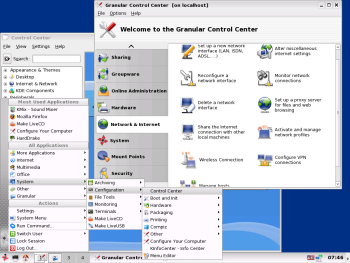Author: Preston St. Pierre
Granular Linux is a desktop-oriented distribution based on PCLinuxOS. Its primary goals are to be easy to use and user-friendly. With the new preview release of version 1.0, Granular has come a long way toward achieving these goals, and becoming a unique distribution with its own benefits and problems.
Upon booting the Granular live CD ISO with the default settings my test PC, which uses an old ATI Rage 128 video card, the system froze at the loading screen. A quick reboot and selection of safe VESA settings solved this problem with no fuss. Considering I can no longer get this card to work properly under Windows, I count it as a blessing when it runs under Linux. This is another example of how Linux breathes life into old hardware. Before bringing me to the desktop, Granular asked me to select my keyboard layout and network settings. It remembered and used the settings in the installed system without asking again, which pleased me greatly.
When you log in to the live CD desktop as root you’ll see a shortcut on the desktop to install Granular. Since I was more interested in installation than using the distro as a live CD, I clicked on the shortcut and began an easy setup process. Granular asks only a few questions, such as which partitions to use and where to mount them. It took about five minutes to copy the files over on a 1.60GHz Pentium 4 system with 512MB of memory, which made for an extremely decent overall install time of less than 15 minutes, including the first freeze. Before rebooting, I was asked to configure the boot loader settings, along with the root password and any user accounts. Under advanced settings there were options to set up authentication to an LDAP server, NIS server, Windows domain, or Active Directory via Windows Services for Unix or Winbind. Home users can generally ignore these, but business users may find them useful. I added my regular locally authenticated user and rebooted to the freshly installed system.
Granular supports two menu styles, KBFX and Kickoff, and you must select which you wish to use. KBFX is the Granular-style menu, and Kickoff is SUSE style. Nevertheless, Kickoff is noted as the recommended menu style; the 1.0 preview release notes say it’s now the default menu for both root and guest desktops, so I selected Kickoff. While the default desktop is KDE, E17 is also available for selection at the login screen.
Upon logging in I was informed (as happened during the live boot) that the aRts sound server could not be started. When I tried HardDrake, the included application used for hardware configuration, it correctly detected my onboard AC’97 audio and claimed it was working properly — but aRts still refused to start. I tried selecting OSS and ALSA instead, to no avail. I ran alsaconf, which claimed to have correctly detected and configured the card and made sure ALSA was the selected sound system, but still had no luck. After noting on the Granular’s Web site that this version of the distribution is the first to feature its own repository (instead of using the PCLinuxOS repository) I opened up Synaptic and ran a full upgrade, which worked properly but did not provide me with sound. Evenutally I installed a new downloaded copy of OSS, which finally solved the problem.
With sound working I went on to check whether my movies would play. They did, without issue, in the default movie player Kaffeine. MPlayer was also installed as an alternative, as was TVTime for video capture cards. For playing CDs Granular includes KsCD, and Amarok for more in-depth audio playing needs. KWord, KChart, KPresenter, Kivio, KSpread, KPlato, KFormula, Kugar, KThesaurus, and Kpdf are included, making a complete office suite to cover all your needs. The Kexi database designer, Kate text editor, and KRegExpEditor are handy for those inclined toward programming. If you’re just inclined to play games, you’ll find almost three dozen games of various types included. Firefox and Thunderbird handle your Web, email, and newsreading needs.
The mklivecd scripts included with Granular allowed me to make an ISO of the updated system, giving me a live CD in which sound worked, which I could use if I wanted to reinstall Granular in the future. Although difficult to find in a list where there is a System Menu menu, a Settings menu, and a System menu (in which different applications handle similar tasks), the Granular Control Center, located under System -> Configuration -> Configure Your Computer, is also a useful application. It is based on the PCLinuxOS Control Center, which is in turn based on the Mandriva Control Center. It’s not clear from Granular’s Web site what has been changed as compared to the PCLinuxOS version of the control center besides the name, but it is still an easy way to configure many aspects of your system. If you already know what configuration files to edit and which changes to make, you may not need the Granular Control Center, but if you’re tired of trying to keep up with the latest updates and just want a GUI to it for you, or you simply don’t want to bother learning what goes on under the hood, this utility will ease your life.
With a single CD’s worth of included programs, Granular Linux manages to cover a significant portion of normal end user needs, and those applications not already installed can be easily added through Synaptic. The slight problem with video and more serious problem with sound of my machine suggest that Granular is not without its issues, especially when most other distributions work properly on this hardware, but as this is a preview release of version 1.0 I think it can be more or less forgiven. I’d definitely recommend Granular to anyone with an interest in trying out a new distribution.
Categories:
- Granular
- Reviews
- Linux
- Distributions




